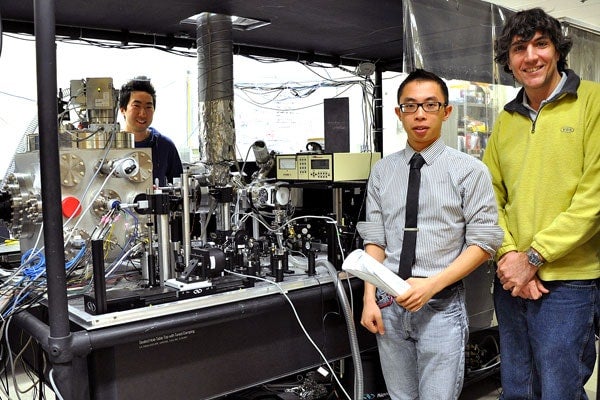
Scientists produce best image yet of atoms moving in real time
Published: April 18, 2013
Call it the ultimate nature documentary. Scientists at the University of Toronto have recorded atomic motions in real time, offering a glimpse into the very essence of chemistry and biology at the atomic level.
Their recording is a direct observation of a transition state in which atoms undergo chemical transformation into new structures with new properties – in this case the transfer of a charge leading to metallic behaviour in organic molecules. It is described in a study reported in the April 18 issue of Nature.
“It’s the first look at how chemistry and biology involve just a few key motions for even the most complex systems,” said U of T chemistry and physics professor R. J. Dwayne Miller, principal investigator of the study. “There is an enormous reduction in complexity at the defining point, the transition state region, which makes chemical processes transferrable from one type of molecule to another. This is how new drugs or materials are made.”
Miller, who holds a joint appointment as director of the Max Planck Research Group for Structural Dynamics at the Centre for Free Electron Laser Science, conducted the research with colleagues from institutions in Germany and Japan. He said nature uses this reduction principle at transition states to breathe life into otherwise inanimate matter.
“Imagine the complexity of all the enormous number of possible arrangements of atoms in DNA or any other biologically active molecule. It always does the same thing to drive a biological function. We can now see how all these possible motions become coerced along a particular pathway by a dominant player.”
 To help illuminate what’s going on, Miller explained that with two atoms there is only one possible coordinate or dimension for following the chemical pathway. With three atoms, two dimensions are now needed. However, with a complex molecule, it would be expected that hundreds or even thousands of dimensions would be required to map all possible trajectories of the atoms.
To help illuminate what’s going on, Miller explained that with two atoms there is only one possible coordinate or dimension for following the chemical pathway. With three atoms, two dimensions are now needed. However, with a complex molecule, it would be expected that hundreds or even thousands of dimensions would be required to map all possible trajectories of the atoms.
“In this case, chemistry would be a completely new problem for every molecule,” said Miller. “But somehow there is an enormous reduction in dimensions to just a few motions, and we are now able to see exactly how this works at the atomic level of detail.”
The result builds on a milestone Miller and some former graduate students first reached a decade ago.
“One of the longstanding dream experiments is to directly observe atomic motions during the defining moments that lead to structure change, and we were able to watch simple phase transitions at the atomic level back in 2003,” said Miller. “This led to a new understanding that now allows for minimally invasive laser surgery. It’s a testimony to the importance of basic science and never knowing where new understandings will lead.”
“The first atomic movies were very grainy, much like the first motion pictures,” said Miller. “The new movies are so clear one could dare say they are becoming beautiful to behold, especially when you remember you are looking at atoms moving on the fly. We’ve captured them at an incredibly fast rate of less than 1 millionth of a millionth of a second per frame.”
The breakthrough was based on the development of ultra-bright electron sources that dates back to the 2003 work.
“Other researchers use x-rays to capture atomic motions, so no one thought we could ever develop a bright enough source based on electrons as they undergo electron-electron repulsion and would blow up without being able to capture an image on the incredibly short time scale required,” said Miller. “We found a way to coerce the electrons into an ultra-short pulse sufficiently bright to literally light up atomic motions as they occur.”
“Electrons interact with atoms one million times stronger than x-rays and can be produced with a table-top instrument to efficiently produce enormous, effective brightness for viewing atomic motions.”
Funding for this research was provided by the Natural Sciences and Engineering Research Council of Canada and the Canada Foundation for Innovation. Additional support was provided by the Max Planck Society in Germany, a Grant-in-Aid for Scientific Research on Innovative Areas and the G-COE program for the field of Chemistry from The Ministry of Education, Culture, Sports, Science and Technology in Japan, and by Creative Scientific Research from The Japan Society for the Promotion of Science.



